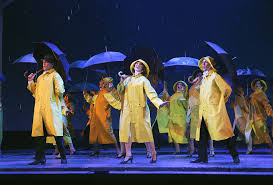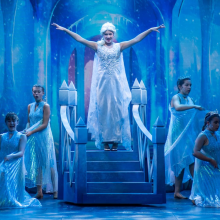Filichia Features: Singin' (and Dancin’) In The Rain
Filichia Features: Singin' (and Dancin’) In The Rain
You want to do a musical that has solid name recognition -- a great big Broadway show -- but you want to challenge yourself and your staff, too.
How 'bout Singin' In The Rain?
The 1985 stage adaptation of the beloved 1952 film still offers that wonderful Betty Comden and Adolph Green wit. They had a rich subject to mine: what happened when technology allowed silent movies to finally speak. Dashing leading man Don Lockwood and his excellent voice had no trouble making the transition, but, oh that Lina Lamont, whose high-pitched nasal voice sounded as if she’d been gargling with razor blades. Bless Cosmo Brown from the music department for coming up with the idea of using Don’s new girlfriend Kathy Selden to dub Lina’s voice.
Long before people began using the term “jukebox musical” – meaning a show that features second-hand songs inserted into a new plot – Singin' In The Rain was on the ground floor of the convention. Comden and Green were given a bunch of old songs by Nacio Herb Brown and Arthur Freed and were told to find a story that would fit them. The result was a film that is ranked as the fifth-best of all time by the American Film Institute.
That it would reach the stage would seem natural, except for two components: one, there are four film sequences that need to be accomplished: a silent in which Don and Lina perform well; a talkie that shows him shining and her sinking; another talkie for which Kathy provides what Lina can’t; and a film that features an erudite man simply looking at the camera and speaking in order to illustrate the possibilities of talking films.
Today, virtually every theater company has or knows a technical wizard who can digitally make “black-and-white films.” At the University of Cincinnati-Conservatory of Music last week where Singin' In The Rain triumphed, director Diana Lala admitted that having the school’s Electronic Media Program was an immense help. “We also needed the right location to film The Royal Rascal,” said Lala, citing the Louis XIV-era film that would be Don and Lina’s last silent hit. “Finding the place that looked period and booking it was its own mountain to climb. We also needed a fight choreographer to direct it because it involved so much sword fighting.”
But what about the sequence that has Don is so in love that he celebrates by singin’ and dancin’ in the rain? What a glorious feeling you want to give your audience – but can you?
Lala lauded crackerjack technical director Steve Miller. “He and three of his students designed it through pipes with holes,” she said. “The stage was slightly raked so the water would roll down. Upstage we had a section that came out so the water could puddle” – for the sequence in which Don goes splashing about.
Granted, the cost of rain was around $2,500 – because Lala wanted it done correctly. “I’ve seen the show where you look at the stage and see sprinklers, so there’s no magic,” she said. “The rain was especially great here because you couldn't see the source of it.”
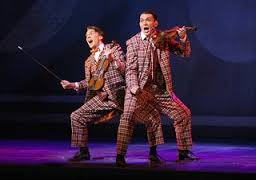
Most shows end their first acts with what-will-happen-next conflict? Not Singin' In The Rain, for the title number must be followed by an intermission – which gives the stage crew time to rid the stage of all that fallen water. As it turned out, the moment that the lights came up for intermission, so did the curtain that had just descended. Out came a team of techies with industrial strength vacuum cleaners and mops. Many in the audience gave the group a hand; they assumed that the curtain was up to give them yet another show in itself. No – the curtain needed to be up so that every drop of water could be eliminated. The procedure also meant a slightly longer intermission; 20 minutes were needed before the stage was safe again.
Here's a show where your leading man not only requires a dresser, but also a dryer. Max Clayton, who played Don, was superbly soaked and never let the rain get in his way of delivering a delicious dance that homaged what Gene Kelly did lo those 60-plus years ago. His multi-million dollar smile was shown to good advantage on stage and screen.
As Lina Lamont, Sarah Bishop was required to speak in that squeaky yet hoarse voice that helped Jean Hagen receive an Oscar nomination. One might wonder if maintaining that sound for two-plus hours in plenty of scenes might turn out to play havoc with vocal cords. Happily, Bishop claims she's just fine, thank you. (She was fine in the show, too.)
Cosmo maneuvered through the arduously entertaining “Make ‘em Laugh.” He threw himself onto the stage and into a plank of wood, made funny faces and played with a dummy while singing a fast-paced song. Advises Peter Marx, who originated the role on Broadway when he was known as Peter Slutsker, “Wear protective gear.”
Matt Hill did and managed it all magnificently. He also had the necessary acumen to play the person who was the smartest in the room: the only one who didn’t pooh-pooh the advent of talkies but took a wait-and-see attitude because he’d already lived long enough to know that anything is possible.
Katie Wesler’s Kathy Selden improved upon Debbie Reynolds in one important scene – when she meets Don and tells him what’s wrong with the movies and how grand the legitimate theater is. Wesler was less caustic and almost made her speech come across as constructive criticism. Better still, in every song and dance with Don she beautifully calibrated her thought processes from “Could this be the man for me?” to “This is definitely the man for me.”
Also excellent was Connor Deane as the studio head. Here’s a performer in his early twenties who had to play a mogul in his fifties. But if you have the soul of a character man, you have it. Deane showed a hands-in-one-pocket, cigar-in-other ease.
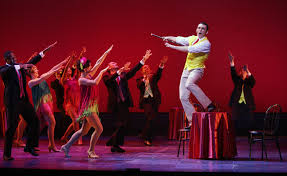
(After the closing performance, I also praised him for the way that he wore a coat over his shoulders the way the big shots like to do. He told me that he had to wear it that way because the demands of the scene didn’t give him the time to put his arms in the sleeves. I think you may anticipate that I’m about to write a sentence with the words, “life,” “gives,” “lemons” and “lemonade.”)
After the final curtain came down, the audience immediately showed its intense appreciation. But, to paraphrase a line from The Jazz Singer, they hadn't seen anything yet. For the curtain call, Lala put all 38 cast members in yellow slickers and hats and gave each a large umbrella to combat the reprise of the rainstorm. Yes, it was an added expense, but it turned out to be worth it: if the audience hadn't been ca-razy for the show to begin with, it now amped its applause to unprecedented heights.
But wait! More than three dozen people dancin' and singin' in the rain awfully close to each other on a slippery stage? Doesn't at least one performer go slippin' in the rain?
No, and each performer said he never came close to taking a tumble -- not in that scene, anyway. Actually, something else -- something seemingly innocuous -- turned out to be an on-stage hazard.
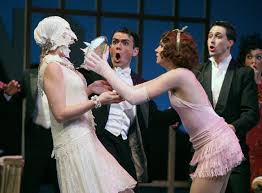
It happened after Kathy popped out of the cake at the party and Don mercilessly teased her, citing her recent harangue on True Art. Kathy responded by picking up a cream pie and throwing it at his face -- but Don ducked and Lina's the one who got it pow in the kisser.
The trouble is that some of the cream concoction flowed from Lina's face and onto the floor, where it created a sticky residue. And there was the rub for the cast. Although an effort was made to get every speck off the floor, there still was enough there to stop a performer while dancing the choreography designed by Lala and Patti James.
So here’s where the rain became a blessing. Once the rain poured down and cleansed the stage in the Act One finale, the performers no longer had to worry when they approached that spot.
Back in 1971, Singin' In The Rain was mocked in the film A Clockwork Orange. Its anti-hero Alex sang the title song while involved in an unspeakable act of violence. Time has passed, and Singin' In The Rain has remained an audience favorite while A Clockwork Orange has seen its luster fade a bit. Yes, it’s ranked as the 70th greatest film of all time by the American Film Institute. But that’s not the same as the fifth-greatest, is it?
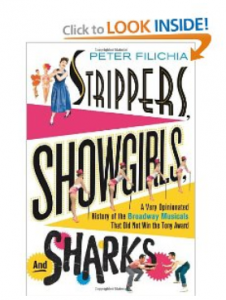
You may e-mail Peter at pfilichia@aol.com. Check out his weekly column each Tuesday at www.masterworksbroadway.com and each Friday at www.kritzerland.com. His new book, Strippers, Showgirls, and Sharks – a Very Opinionated History of the Broadway Musicals That Did Not Win the Tony Award is now available at www.amazon.com.
